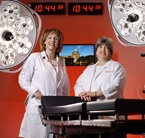
In one of the new obstetric ORs, obstetrics Nurse Manager Joan Diamond with NICU Nurse Manager Sue Culp.
For high-risk premature neonates, unnecessary movement is the enemy—a message neonatologist Sue Aucott took to heart in helping to design Johns Hopkins new neonatal intensive care unit (NICU). Critical to safe and efficient transport, she stressed, is a close proximity between Labor & Delivery and the NICU—The Sutland/Pakula Family Newborn Critical Care Center.
“Having the units apart adds an extra challenge to moving babies, especially critically ill newborns,” Aucott says. “The less movement for the babies the better.”
In the new configuration, moving is minimal. The NICU and Labor & Delivery are within a whisper of each other on the eighth floor of the new clinical building, with the obstetric ORs as a connector so that high-risk neonates will be handed off to NICU staff immediately after delivery. Of course, more than proximity went into planning, says obstetrics Nurse Manager Joan Diamond: “Our units were designed as the ultimate in care, with high-risk newborns in mind.”
Communication is key. OB census screens on NICU computers allow staff to identify high-risk moms in Labor & Delivery. And well before delivery, a neonatologist or fellow will have met with those mothers-to-be and familiarized them with the NICU to prepare for their newborn’s stay. When pre-term labor begins, OB staff text the NICU’s delivery room response team—a NICU resident, fellow, respiratory therapist and admissions nurse—to prepare to pick up the newborn.
“We package the baby into a transport isolette, wheel that by the mom, and then around the corner to the NICU,” says Aucott. “So things go pretty smoothly.”
Should complications arise with any infant, pre- or full-term, Labor & Delivery and the NICU are well-situated as part of an academic medical center with multiple subspecialty services readily available. And earlier in a pregnancy, Hopkins offers fetal echocardiography and genetic testing to inform parents and help guide care.
Another plus: Family-friendly amenities are prominent in the new units, including all-private rooms with sleeping facilities for at least one parent and on-demand meals. In the NICU, parents also have access to three private sleep rooms, as well as cooking, bathing and laundry facilities. And a new nurse-call system that eliminates overhead pages means a quieter environment for newborns and their families.
“Parents who are more comfortable in their surroundings make it much easier for us to care for babies,” says NICU nurse manager Sue Culp. “With a private room and decreased stimulation, they really get to focus on their babies.”
For more information, click here.
